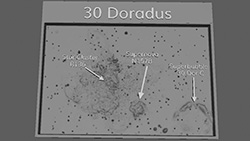CXC Home | Search | Help | Image Use Policy | Latest Images | Privacy | Accessibility | Glossary | Q&A
1
X-ray, Infrared, Optical, and Radio Images of 30 DoradusCredit: X-ray: NASA/CXC/Penn State Univ./L. Townsley et al.; Infrared: NASA/JPL-CalTech/SST; Optical: NASA/STScI/HST; Radio: ESO/NAOJ/NRAO/ALMA; Image Processing: NASA/CXC/SAO/J. Schmidt, N. Wolk, K. Arcand
Chandra captured the deepest X-ray image ever made of the spectacular star forming region called 30 Doradus. These images show the X-rays from Chandra, as well as optical data from Hubble, infrared data from Spitzer, and radio data from ALMA, and reveal one of the brightest and crowded regions of star formation relatively close to Earth. The Chandra data shows thousands of individual star systems as X-ray sources plus a diffuse X-ray glow from winds blowing off giant stars and gas expelled by supernovas.
2
3D Printable Files: 30 Doradus(3D Print Credit: NASA/CXC/A. Jubett, using software by Tactile Universe/N. Bonne & C. Krawczyk & Blender)
This tactile plate is a physical relief map based on the intensity of Chandra X-ray data along with optical, radio and infrared data, featuring a highly detailed composite image of a star-forming region of space known as 30 Doradus, shaped like a bouquet, or a maple leaf.
30 Doradus is a powerful stellar nursery. In 23 days of observation, the Chandra X-ray telescope revealed thousands of distinct star systems. Chandra data also revealed a diffuse X-ray glow from winds blowing off giant stars, and X-ray gas expelled by exploding stars, or supernovas.
In this plate, the X-ray wind and gas takes the shape of a massive encompassing bouquet with an extended central flower, or perhaps a leaf from a maple tree. The slightly-raised, mottled shape occupies much of the image, positioned just to our left of center, tilted slightly to our left. Inside the gas and wind cloud are ridges of veins, and pockets of protruding bumps. The pockets of bumps represent clusters of young stars. One cluster at the heart of 30 Doradus houses the most massive stars astronomers have ever found.
The overall bouquet is surrounded by pointy dots. A second mottled cloud shape, which resembles a ring of smoke, sits in our lower righthand corner.
In a second tactile plate, relief-map labels point out three key features: Star Cluster R136, roughly in the center of the bouquet shape, Supernova N157B, central from left to right and close to the bottom of the plate, and Superbubble 30 Dor C, the “ring of smoke” mentioned above.
30 Doradus is a powerful stellar nursery. In 23 days of observation, the Chandra X-ray telescope revealed thousands of distinct star systems. Chandra data also revealed a diffuse X-ray glow from winds blowing off giant stars, and X-ray gas expelled by exploding stars, or supernovas.
In this plate, the X-ray wind and gas takes the shape of a massive encompassing bouquet with an extended central flower, or perhaps a leaf from a maple tree. The slightly-raised, mottled shape occupies much of the image, positioned just to our left of center, tilted slightly to our left. Inside the gas and wind cloud are ridges of veins, and pockets of protruding bumps. The pockets of bumps represent clusters of young stars. One cluster at the heart of 30 Doradus houses the most massive stars astronomers have ever found.
The overall bouquet is surrounded by pointy dots. A second mottled cloud shape, which resembles a ring of smoke, sits in our lower righthand corner.
In a second tactile plate, relief-map labels point out three key features: Star Cluster R136, roughly in the center of the bouquet shape, Supernova N157B, central from left to right and close to the bottom of the plate, and Superbubble 30 Dor C, the “ring of smoke” mentioned above.
Return to: NASA Telescopes Deliver Stellar Bouquet in Time for Valentine's Day (February 12, 2025)









